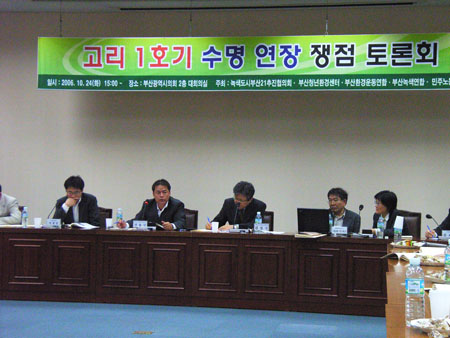 |
|
Photo: From left, Seok Kwanghoon, Kim Yongguk, chair Kim Sung Kuk, Mitsuhiko Tanaka and interpreter Kim Bonnyo
|
On October 24th I attended a symposium in Busan, South Korea, concerning the life extension of Kori-1 nuclear power plant (NPP). Mitsuhiko Tanaka, a member of CNIC's Citizens' Research Group on Nuclear Power Plant Aging Issues, was one of the panelists.
Kori NPP is located 30 kilometers north-east of Busan City, which has a population of over 3 million people. Kori-1 (587 MW) is South Korea's oldest NPP. It commenced operation on 29 April 1978. The plant was imported from the US (Westinghouse) and is operated by Korea Hydro and Nuclear Power Company (KHNP). Its original design life of 30 years runs out in June 2007. By rights it should be closed down at that point, but the Nuclear Energy Law was revised in May 2005 to allow extensions beyond the design life and in June this year KNHP applied for a further 10-year license extension. The Ministry of Science and Technology will consider the application and make a decision within 18 months.
The original intention was that the symposium would take the form of a debate between the government (Ministry of Commerce Industry and Energy, Ministry of Science and Technology), KHNP and citizens. The debate would address the following three issues: safety, need and social acceptance. However, immediately before the symposium, KHNP and the government pulled out giving various excuses, including the commotion surrounding the North Korean nuclear test. As a consequence all the panelists came from the citizens' side.
Mitsuhiko Tanaka explained the Japanese situation. The system in Japan was revised in September 2003 to require companies to adopt measures in response to the issue of aging NPPs and to set maintenance standards. Before plants turn 30, a technical assessment of major components must be performed and a long-term maintenance plan must be established. If these measures are approved, a license extension of 10 years can be granted. Up to three extensions may be granted, giving a maximum operating life of 60 years. Tanaka pointed out that this is an extremely optimistic system.
Most of South Korea's reactors are pressurized water reactors (PWR). Tanaka stressed the importance of paying careful attention to developments related to aging PWRs in Japan and the US, for example problems with reactor vessels such as cracked nozzles and embrittlement caused by neutron irradiation (see article on page 2). He said that Japanese citizens' groups are keen to cooperate on technical issues.
The other panelists besides Mitsuhiko Tanaka were Seok Kwanghoon of Green Korea United and Kim Yongguk, legislative assistant to Democratic Labor Party MP Chun Young Se and activist opposed to the Yonggwang NPP. Seok Kwanghoon presented analysis showing the risk of excess load on the grid and future surplus capacity. Speaking from past experience, Kim Yongguk stressed the importance of not letting the government and KHNP deceive them.
Chihiro Kamisawa (CNIC)
Return to NIT 115 contents

